[Myanmar] Review—The Lady And The Peacock
-
Recently Browsing 0 members
- No registered users viewing this page.
-
Topics
-
-
Popular Contributors
-
-
Latest posts...
-
17
Border Thailand Reopens Three Border Checkpoints with Cambodia to Boost Cross-Border Trade
I think he got that. That's why he almost got excited.. -
159
The official sinsod calculator for Thai marriages
Go talk to Malcolm. His topic. -
5
Report Most Thais Say Rogue Monks Must Face Punishment, Survey Finds
The 227 rules of the pātimokkha monks are allowed alms bowls and robes only. Money an eating are midday are clear no-nos. Each temple's clergy should recite these on full moon and half moon days I understand. Fancy ordaining anyone? Stick with the Cathlolics or Anglicans and you will get moved to another parish if you stick your hand up the altar boys cassocks. -
267
Trump just made an idiot move
It's more a case how we have to wonder about so many people having no qualms to post innuendo, gossip and unevidenced conspiracy theories. -
6,828
-
9
Report Thailand Braces for Downpours as 'War Room' Springs into Action
And what crap are they talking about now Northern North Northern Vietnam comes across Lao and Northern Thailand not the south
-
-
Popular in The Pub





.thumb.jpeg.d2d19a66404642fd9ff62d6262fd153e.jpeg)








Recommended Posts
Create an account or sign in to comment
You need to be a member in order to leave a comment
Create an account
Sign up for a new account in our community. It's easy!
Register a new accountSign in
Already have an account? Sign in here.
Sign In Now